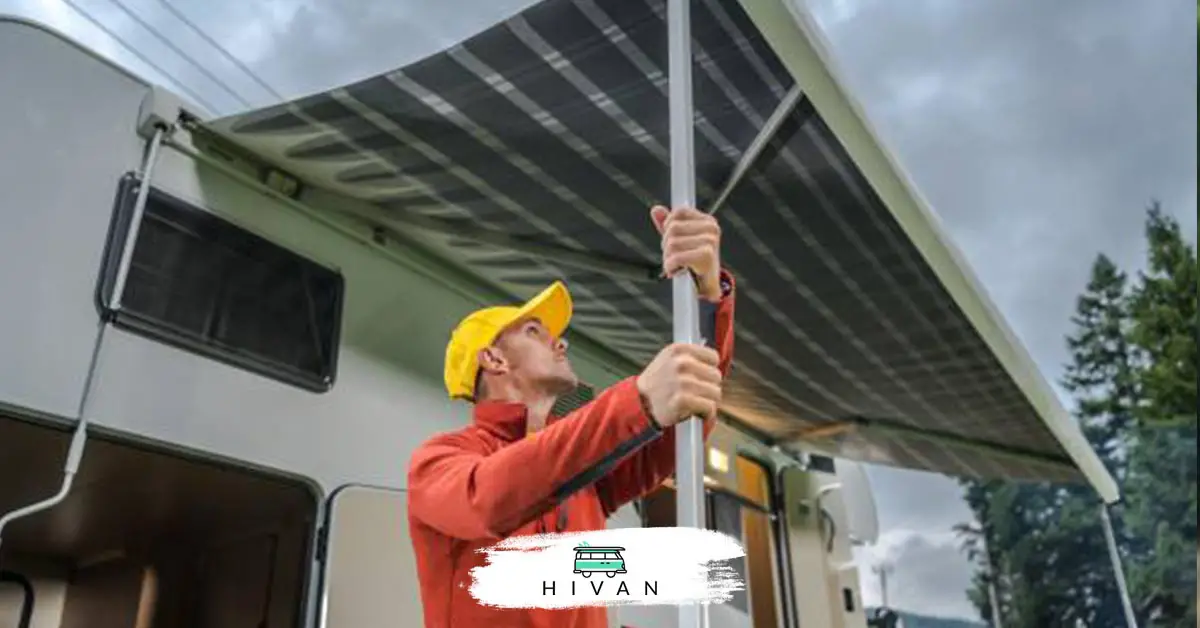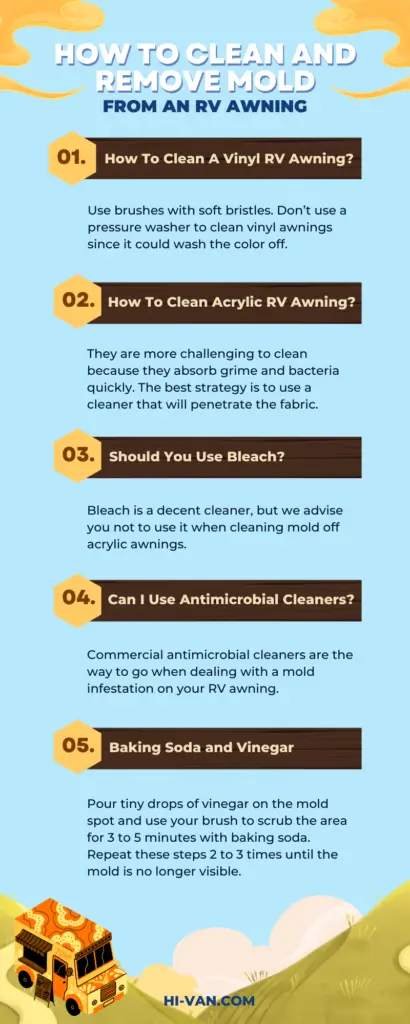Hi-van is supported by its audience. When you purchase using our links, we may earn an affiliate commission (no added cost to you). Learn more
Have you noticed mold growing on your RV awning?
It’s not uncommon for mold and mildew to grow on awnings due to exposure to moisture and humidity, but don’t worry, I’m here to help!
In this article, we’ll walk you through the steps to clean and remove mold from your RV awning, using simple and easy-to-follow instructions.
Plus, I’ll share some tips to prevent mold growth in the future, so you can keep your RV awning looking clean and new. So let’s get started and say goodbye to that pesky mold!
To clean and remove mold from an RV awning, first, remove any loose dirt or debris from the awning using a soft-bristled brush or a broom. Then, prepare a cleaning solution adapted to your awning. Apply the cleaning solution to the awning using a soft-bristled brush or a sponge, let it sit for 10 minutes, then rinse the awning thoroughly with a garden hose or a pressure washer.

We buy campers to escape the modern world and spend one-on-one time with nature. One of the essential accessories of a camper is its awning. It protects you from the sun and inevitable rainstorms when spending time outdoors. While shielding you from the weather, your awning also accumulates leaves, mold, and other filth that we accept as outdoors people.
This guide will teach you the necessary steps to take when cleaning mold off your RV awning and what you can do to prevent it from forming less often.
Cleaning Techniques for Two Types of RV Awning Materials
The two most common awning materials to choose from are vinyl and Acrylic. You cannot clean them using the same methods because they are both unique. This section will show you how to clean each one.
Cleaning and removing mold from an RV awning can be a challenging task. Here are general steps you can follow to get rid of mold from your RV awning:
- First, remove any loose dirt or debris from the awning using a soft-bristled brush or a broom.
- Prepare a cleaning solution adapted to your type of awning (Viny Awnings, Acrylic Awnings).
- Apply the cleaning solution to the awning using a soft-bristled brush or a sponge. Make sure to cover the entire surface of the awning.
- Let the cleaning solution sit on the awning for about 10 minutes.
- Rinse the awning thoroughly with a garden hose or a pressure washer (keep the nozzle far from the awning surface to avoid any potential damages).
- If the mold stains are still visible, repeat the cleaning process until the stains are completely removed.
- After cleaning, let the awning dry completely before applying any protecting coating.
- To prevent mold from growing on the awning again, make sure to keep it dry and clean regularly.
Note: Always wear protective gloves and eyewear when working with bleach. Avoid using harsh chemicals or abrasive cleaners that can damage the awning material.
How To Clean A Vinyl RV Awning
Vinyl is a popular material for RV awning construction due to being naturally mildew resistant and non-porous, making it easier to clean.
You can gently scrub vinyl with a soft brush to remove dirt and stains without having to worry about damaging the surface.
While vinyl is hardy, it is not recommended to pressure wash it frequently as it can cause the color to wash off. Additionally, because of its non-porous nature, cleaning solutions like bleach can be effective at killing mold and mildew on vinyl almost instantly, without needing to soak for long periods of time.
How To Clean Acrylic RV Awnings
Campers love Awnings constructed with acrylic, which is why awning suppliers always stock the material. Unlike vinyl, this material has a porous exterior. Materials with porous surfaces are more challenging to clean because they absorb grime and bacteria quickly. One distinct advantage it offers is a rainproof outer layer.
The technique you use to clean vinyl awnings won’t be effective with acrylic because a deep cleanse is required. The best strategy is to use a cleaner that will penetrate the fabric. Once you apply the cleaner, roll up the awning and give it a few hours until you can unroll it and scrub it with a stiff-bristled brush. Utility quality cleaning brushes dig deep into porous surfaces and get grime between woven fibers efficiently.
An optional tip we recommend is to put a thick coat of waterproofing spray after the above steps for an extra layer of defense for your acrylic awning.
- Waterproofs and protects fabrics
- Also great for outdoor furniture, pop-up campers, RV covers and tents
- Restores water repellent qualities to fabric
How To Clean and Get Rid of Mold From Your RV Awning
Removing mold from your RV awning is more of a chore than getting rid of mildew. The worst kind is called black mold. It can be destructive and spread like wildfire in moist environments. Black mold is most prevalent in humid states like Mississippi and Arkansas.
Similar to mildew, mold thrives in climates that are wet and have very little light. Because of this, a moist RV awning rolled up provides the ideal place for mold to reproduce and spread. What makes mold so burdensome to clean is the fact that it penetrates and lodges itself deep within any fabric.
Related Articles:
– Is your RV roof turning black? This might be why
– How do you clean flexible solar panels?
Should You Use Bleach to Clean your RV Awning?
Bleach is a decent cleaner, but we advise you not to use it when cleaning mold off acrylic awnings. Since acrylic has absorbent fibers, the mold is too deep inside the awning, and bleach is only effective at cleaning non-porous surfaces.
If you try to use bleach, it’s misleading because you will see the exterior of the awning perfectly cleaned, but there will still be mold in the roots of the fiber. Come back in a few days, and you will see it making a comeback right up to the surface with tons of gray dots on your RV awning.
Anyone who purchased a vinyl awning is welcome to use bleach without issues. All you need to do is 4 ounces of water with 4 ounces of bleach in a spray bottle. Then you can spray thick coats on the awning and give it 8 to 10 minutes. Lastly, take a brush with a soft bristle and scrub the exterior while pouring water on it every few minutes until there is no excess bleach left.
Can I Use Antimicrobial Cleaners?
Commercial antimicrobial cleaners are the way to go when dealing with a mold infestation on your RV awning. Deal with the problem early, which usually covers a small area at this point, and you can keep the mold from spreading. These store-purchased cleaners are available at brick-and-mortar stores like Lowes and online retailers.
Baking Soda and Vinegar
Not everyone likes the smell of the chemicals in commercial cleaners, and they are not always safe to inhale when you spend long hours under your awning. The good news is that you have other options that are all-natural and safe to work with when eliminating mold from your RV awning.
The organic alternative will require you to have vinegar and baking soda at home. First, pour tiny drops of vinegar on the mold spot and use your brush to scrub the area for 3 to 5 minutes with baking soda. Repeat these steps 2 to 3 times until the mold is no longer visible.
Summary
When outdoors people clean their RVs, they often ignore their awnings which is a bad idea. Setting up a time to clean this part of the camper every week is vital when following a proper maintenance plan to ensure small mold stains don’t turn into larger ones. Lastly, if your awning is wet after a rain shower, dry it with a towel before storing it.
Lastly, here’s a infographic that will help you reminder everything you need to clean your RV awning




